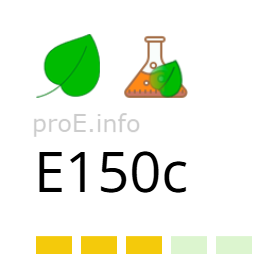
Other names for the additive (synonyms)
General Information
The food colorant E150c (Caramel Color III) belongs to the group of colorants E150. It is a natural or nature-identical colorant produced by the thermal decomposition of carbohydrate-containing substances.
The main difference between additive E150c and other E150 colorants lies in its use of the "ammonia process": during heating, ammonium compounds are added to the carbohydrate material.
Raw materials used include carbohydrate substances such as sucrose, glucose, invert syrup, corn syrup, and maltodextrin.
During heating to temperatures of 120–150 °C and subsequent caramelization, ammonium compounds are added: ammonium hydroxide (NH₄OH), ammonium carbonate ((NH₄)₂CO₃), or ammonium bicarbonate (NH₄HCO₃).
The resulting colorant E150c is well soluble in water and insoluble in ethanol. The additive is resistant to light, oxidation, and temperature fluctuations. It withstands heating up to 150 °C.
Main characteristics of additive E150c:
- Color – dark brown.
- Taste – sharp and bitter.
- Consistency – powder, thick liquid, or solution.
- Odor – burnt sugar.
Effects on the Body
Benefits of additive E150c
The entire E150 class of additives belongs to the melanoidin pigments – complex molecules derived from plant tissues. These compounds possess radioprotective properties and help protect the body from radiation exposure and related mutations.
Risks of additive E150c
Additive E150c may cause gastrointestinal issues if the acceptable daily intake is exceeded – 150 mg per 1 kg of body weight.
According to the scientific opinion of the EFSA Panel on Food Additives, colorant E150c is considered safe for use in food products.
Uses
The food colorant E150c is used to color a wide variety of food products:
- vinegar;
- fermented dairy products – ryazhenka, kefir, sour milk;
- alcoholic beverages – wine and beer;
- bitter soft drinks – soda, punch, iced tea, cola;
- lemonade;
- breakfast cereals – puffed rice, cornflakes, corn sticks;
- fruit and vegetable preserves;
- jam, jelly, marmalade;
- meat products – sausages, frankfurters, cooked sausages, pâtés;
- sauces;
- canned soups.
This colorant is also used in the production of animal feed.
Legal Status
The food additive E150c is approved for use in the food industry in Ukraine, the EU, and the United States.
For more detailed information about the benefits and risks of additive E150c, see the main page of the E150 additive group.